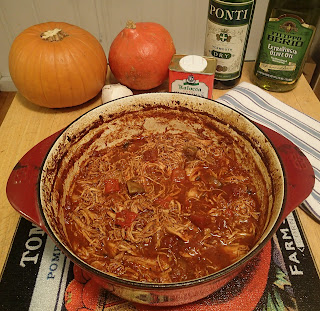I've been enjoying the Facebook posts from my friend Stephanie who is stationed in Japan, and they've got me a-hankerin' for some Japanese food. Not that it takes much for me to want some nihon-ryōri...I'm pretty sure I was Japanese in a past life. With the cool weather upon us, I was looking for a hearty soup. I ordered some Nabeyaki Udon from a local Japanese-slash-Chinese restaurant, and was pretty let down. So, I thought I'd give it a shot making from scratch. Now I feel foolish for paying $20 for something so easy to make.
Udon are a thick, chewy wheat noodle, served hot in soups, pan fried, or either hot or cold with dipping sauces. The have a very pleasant al dente texture, and are best either fresh or frozen. I used frozen, as do most American Japanese restaurants. I may try making them from scratch. They are deceptively simple, just flour, salt, and water, but it seems there is an art to getting the proportions just right, as well as creating the right gluten development through pounding or kneading (traditionally through stomping on the dough in a bag). In any case, the frozen were very nice, and only needed to be dropped in the broth and heated through.
Wakame is the green seaweed typically found in miso soup. It comes dried in shreds, looking like black tea. Soak it in cold water for 5 minutes, and it will bloom into lovely translucent green strips that can be added to the soup. If you cant get wakame, try some blanched or frozen spinach, or similar greens.
Mirin is a sweeter cousin to sake, primarily used for cooking. If you can find it, the better quality mirin will have no added sugar or high fructose corn syrup, but it can be hard to find outside Asia.
Krab sticks are available in the seafood section of most grocery stores, and in Asian groceries. Kamaboko is a fish cake, often colored pink or red on the outside, and is available at Asian groceries. If you can't find it, just add a couple more krab sticks.
This recipe has almost no cooking, and comes together very fast. Have everything prepped before you start, and it will go very easy.
 Udon Soup
Udon SoupServes 2-3 as entree
5 cups hot water
2 tsp instant dashi granules
⅓ cup light shoyu
3 Tbs mirin
2 blocks frozen udon noodles
3 small shitake mushrooms, reconstituted in boiling water if dried
1 Tbs dried wakame seaweed, soaked in cold water and drained
1 Tbs Shiro (white) miso
2 "Krab Sticks" per person
2 slices kamaboko (fish "cake") per person
1 whole raw egg per person
1 scallion, sliced
Soak the wakame in cold water and the shitake in boiling water in a coffee mug, about 5 minutes for both, draining when reconstituted.
Bring water to a boil in a medium pot, reduce to high simmer. Add dashi, shoyu, and mirin. Add udon straight from freezer, heating through and agitating to loosen, about 2 minutes.
Meanwhile heat a large serving bowl by adding very hot water, cover with a pot lid.
When noodles are heated through, add drained wakame to pot. Remove from heat, and stir in miso. Empty serving bowl, then transfer noodles and most of the broth. Sprinkle with half the scallions, and then add the eggs directly into the broth to soft poach, topping with the lid to steam. Meanwhile, drop the krab sticks and kamaboko slices into the pot with the reserved broth to heat through. When the egg has soft poached after a few minutes, add the krab sticks and kamoboko to the pot, sprinkle with remaining scallion, and serve.




















